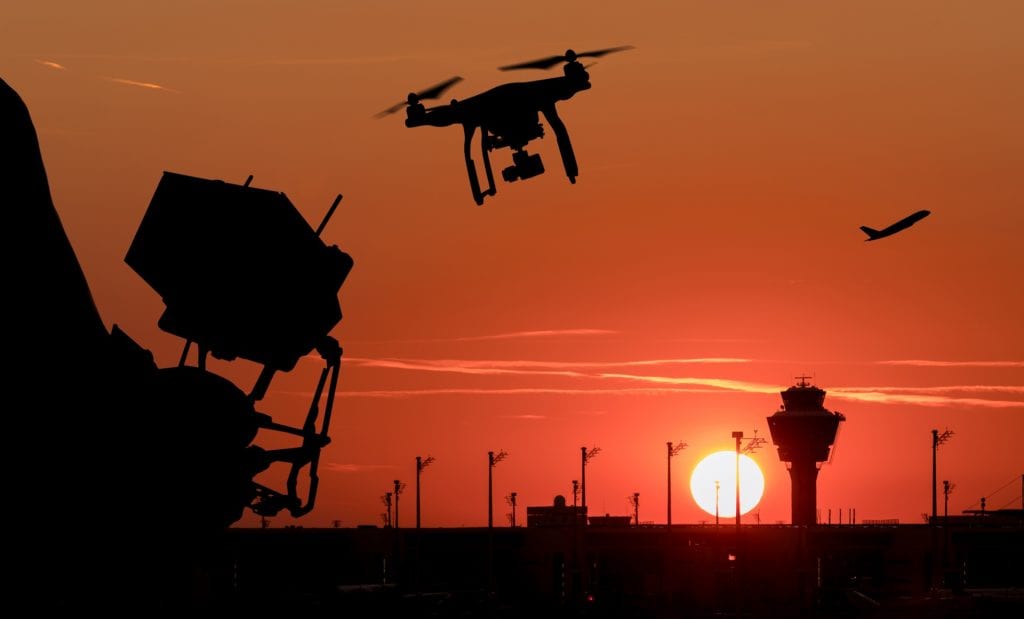
Airports and government agencies are still figuring out where responsibilities and authorities lie concerning drone security and mitigation technologies.
Despite keen awareness of the threats posed by drones, U.S. airports and other large facilities are currently reluctant to purchase counter-drone security systems due to a lack of clarity around regulation, responsibility, authority and effectiveness of technologies.
The Federal Aviation Administration is monitoring the security risks posed by drones as their use continues to proliferate, with the agency expecting $9 billion in drone sales by 2024.
“As the FAA has been looking at this, we’ve been trying to not completely eliminate risk; if we were to do that, we would not maximize use of the airspace,” said Leesa Papier, acting director of the agency’s office of national security programs and incident response. She described efforts to mitigate risk that include education deterrence through law enforcement, as well as the agency’s upcoming drone remote identification rule.
But as events like the December 2018 disruption of service at London Gatwick Airport have shown, education and deterrence are not enough — and a single clueless or nefarious drone operator can have an outsized impact.
That incident resulted in a loss of $25-60 million in revenue for airports and airlines, according to Justin Barkowski, vice president for regulatory affairs at the American Association of Airport Executives, and 160,000 people missed flights. Investigators never determined who was responsible for the threat.
Today, there are more than 530 counter-drone systems on the market, according to the Center for the Study of the Drone at Bard College, with detection methods including radar, radio frequency (RF), eletro-optical and infrared imaging and acoustics. Interdiction methods are various as well, but there is little clarity among industry, government agencies and even the military what systems are most effective for various circumstances.
The FAA, along with the Department of Homeland Security’s science and technology division, is conducting testing and analysis of commercial counter-UAS solutions to develop industry standards for use by airports and other potential purchasers. Those activities, which Papier did not give a timeline for on the FAA side, have been disrupted by the COVID-19 pandemic.
“We’re really anxious to see how we can support the development of efficient technologies that identify and detect UAS that are disruptive,” Papier said. “But at this point in time — other than the testing that we have moving forward — we really don’t have any way of seeing what that positive or perfect solution is going to be.”
“There is no one size fits all solution,” added Lisa Ellman, executive director of the Commercial Drone Alliance, underscoring the difficulty involved in standards formation. “Different technologies may be appropriate for different environments.”
Beyond finding the right solutions, there are issues of responsibility and authority that are in the early stages of being solved. FAA controls the airspace, but airports are privately-owned enterprises; whose responsibility is it to purchase and operate counter-UAS systems — and who has the authority to act on an identified threat?
“As airports, we have very limited capability. We don’t have the legal authority to mitigate or take down a drone. That’s limited to four different federal agencies,” Barkowksi said, referring to DHS, DOE, DOJ and DOD, which have been granted by Congress the authority to take mitigative action toward threatening drones.
There has been progress, Barkowski said, driven by “tabletop exercises” conducted by many airports with government participation.
“As a result, in the event that there is a persistent drone threat at an airport, there is a process now in place to elicit and obtain the assistance and support from those agencies to come and deal with the threat,” he said. However, even that condition — a “persistent drone threat” — isn’t clearly defined.
Airports also don’t have access to drone registration information or low-altitude authorizations that have been granted to drone operators in their airspace, Barkowski said, to understand if identified drones are “friend” or “foe.” Neither do local law enforcement authorities, who are often the first responders to reported drone threats and also do not have authority to take action.
“Yes, absolutely, that’s a gap,” Ellman said of local law enforcement capabilities. “There’s been a lot of talk about pilot programs enabling local law enforcement to test how this would work. Currently, only those four federal agencies currently have authority to use counter-drone mitigation technology. Under the law, there can be data and information-sharing with state and local law enforcement, but there’s no deputization or ability for them to use that technology themselves.”
“I think that’s something where we’ll see some action,” she added. “It is definitely a big issue that would need a statutory solution.”
Papier agreed that determining responsibility and authorization for airspace protection around airports is a “wicked problem” that will require joint effort by government and industry.
“Airports are not owned by FAA, so airports will have to come up with what they’re willing to accept as well, so it becomes a holistic effort on how we address this growing problem.”
This story has been updated to accurately reflect that a quote was said by Lisa Ellman, not Leesa Papier.